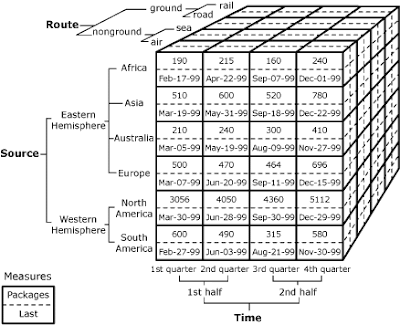- In the 1990's executives became less concerned with the day-to-day business operations and more concerned with overall business functions.
- The data warehouse provided the ability to support decision making without disrupting the day-to-day operations, because :
making.
*Issue of quality information
*Without information history, it is difficult to tell how and why things change over time.
DATA WAREHOUSE FUNDAMENTALS
- Data warehouse - a logical collection of information - gathered from many different operational databases - that supports business analysis activities and decision-making tasks.
- The primary purpose of a data warehouse is to combined information throughout an organization into a single repository for decision-making purposes - data warehouse support only analytical processing.
- Extraction, transformation, and loading (ETL) - a process that extracts information from internal and external databases, transforms the information using a common set of enterprise definitions, and loads the information into a data warehouse.
- Data warehouse then send subsets of the information to data mart.
- Data mart - contains a subset of data warehouse information
MULTIDIMENSIONAL ANALYSIS AND DATA MINING
- Relational Database contain information in a series of two-dimensional tables.
- In a data warehouse and data mart, information is multidimensional, it contains layer of columns and rows
- Cube - common term for the representation of multidimensional information.
- Once a cube of information is created, users can begin to slice and dice the cube to drill down into the information.
- Users can analyze information in a number of different ways and with number of different dimensions.
- Data mining - the process of analyzing data to extract information not offered by the raw data alone. Also known as "knowledge discovery'' - computer-assisted tools and techniques for sifting through and analyzing vast data stores in order to find trends, patterns and correlations that can guide decision making and increase understanding.
- To perform data mining users need data-mining tools
volumes of informations. Eg : retailers can use knowledge of these
patterns to improve the placement of the items in the layout of a mail-
order catalog page or Web page.
INFORMATION CLEANSING OR SCRUBBING
- An organization must maintain high-quality data in the data warehouse.
- Information cleansing or scrubbing - a process that weeds out and fixes or discards inconsistent, incorrect or incomplete information.
- Occur during ETL process and second on the information once if is in the data warehouse.
BUSINESS INTELLIGENCE
- Business intelligence - refers to applications and technologies that are used to gather, provide access, analyze data and information to support decision making effort.
- These systems will illustrate business intelligence in the areas of customer profiling, customer support, market research, market segmentation, product profitability, statistical analysis, and inventory and distribution analysis to name a few.
- Example : Excel, Access














No comments:
Post a Comment